Content
- 1 Possible options for garden flowers for the home
- 2 Agricultural rules for gardeners on the window
- 3 Top dressing
- 4 Land preparation
- 5 Secrets of the correct transplant
- 6 What to do in winter?
- 7 Violet on the windowsill and her photo
- 8 Cacti on the window and windowsill
- 9 Fuchsias on the window
- 10 Geranium on the windowsill
- 11 Begonia on the windowsill
- 12 How to arrange flowers on a windowsill
If you are very fond of garden flowers and want to plant them at home, then this can be done, but difficult. Be prepared to use special techniques to speed up flowering times. For example, perennials need to arrange rest periods (as in natural conditions). But if you are patient and carefully study the peculiarities of the flower variety, you will be rewarded with the lush flowering of your garden favorites.
Possible options for garden flowers for the home
Petunias, zinnias, geraniums, dahlias, begonias and marigolds can grow on the window in the house. For the shady side, marigolds, nasturtiums and annual asters are suitable, as well as climbing plants - beans, beans, sweet peas. Both on the shady and on the sunny side, petunias, calendula, cosmea, nasturtiums grow beautifully.

Garden flower options for home growing
In general, you need to select flowers taking into account the light and heat.
|
Side |
Plant |
Description of conditions |
|
South |
Geranium |
They tolerate excess sun. Withstand drought. They do not lose their appearance, do not fade. |
|
Purslane |
||
|
Kobei |
||
|
Aster, dahlias |
||
|
Calendula |
||
|
Phlox, zinnias |
||
|
Cactus |
||
|
Petunias |
On the south side, they must be watered at least 2 times a day. Therefore, add hydrogel to the soil and plant petunias in deep boxes. |
|
|
West and east |
Petunias, nasturtium, marigolds, asters, dahlias, mattiola |
Almost all garden flowers can grow here, except for cacti, which love the sun. It is important that there is bright sun during the day and cool nights. |
|
Levkoy, heather, tobacco, verbena, calendula |
||
|
North |
Fuchsia |
20-25 degrees is enough for her to bloom magnificently. Be sure to need abundant watering. |
|
Begonia |
Loves partial shade, acidic soil, intense watering |
|
|
Balsam, viola, ivy, mignonette, cyclamen |
Viola requires fluctuations between night and day temperatures - think about how you can organize this. It will be easier on the balcony. |
Seeds are planted with calendula, petunias, cornflowers, bulbs - crocuses, tulips and daffodils. The seeds can simply be sown, but the bulbs must be pressed into damp ground, sprinkled, watered and sprinkled again. For tulips to bloom in early March, you need to plant the bulbs in September.
In addition to flowers, it has become fashionable to plant green beds - spices, herbs, such as basil or mint.
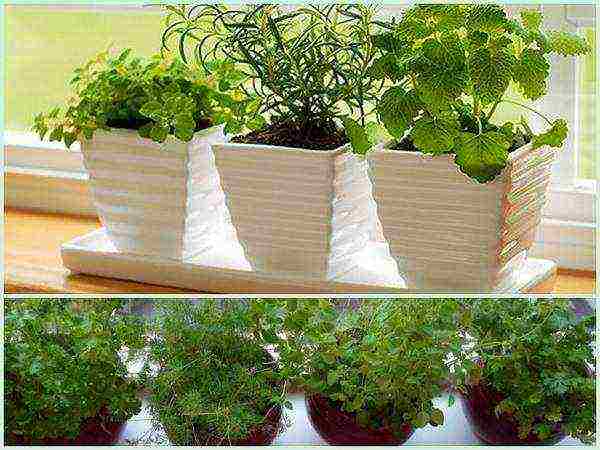
You can grow a spicy garden on the window
Agricultural rules for gardeners on the window
Now breeders are actively developing varieties of garden flowers, adapted to growth and flowering on the balcony, windowsill. But in order to take advantage of the fruits of their labor and grow a garden flower bed at home, you need to know about the features of care:
- Regular watering - the amount of soil in the pot is limited, this is not open ground. Therefore, more frequent feeding and watering are assumed.
When dry, chrysanthemums and tulips often crack the stem, azaleas fall off foliage, hyacinths die of shoots, begonia can even shed their buds. And excess water leads to the fact that the roots rot, the leaves begin to turn yellow and the plant dies.
- Good lighting - the garden in the house a priori will lack light, the window glass does not let all the sun's rays through. From a lack of light, the cuttings rot even at the rooting stage.
Try to keep your garden flowers to the maximum on your balcony, outdoors in your yard, or hang pots from the back of a window (outdoor flower girl).

Ways of placing flowers in the house
- Normal air humidity - when the air is dry, spider mites start on the flowers, and excess moisture causes gray mold and leaf nematodes.
Top dressing
It is important to feed correctly: from an excess of calcium, chlorosis appears on the leaves, and with an excess of nitrogen, plants lose their immunity and are affected by pests.Chrysanthemums, cyclamens and carnations must be fertilized with phosphorus or phosphorus-potassium compounds. They will reduce infestation by aphids, blackleg, rust, and mold.
Land preparation
The land for planting garden houses can be of four varieties: leaf, humus, turf, peat. They are combined with each other and added to the mixture of moss, lime, ash, coal, sand as needed:
- Sod soil improvement - sand (river or lake white).
- Giving lightness, friability, hygroscopicity - sphagnum moss. But before adding it to the ground, it must be properly ground into powder. But with whole moss, you can cover the soil in pots, right on top, so that moisture does not go into the heat.

Four types of earth are mixed in suitable proportions
Young perennials require light soil - there should be a large percentage of leaf and peat soil in it. When they grow up, you need to move from leafy soil to soddy.
Another good option is garden soil that is 2: 1 mixed with compost. You need to add sand and charcoal or sawdust to it.
Secrets of the correct transplant
It is necessary to transplant in a timely manner, as the plant grows
See that there is no extra land that is not permeated with roots: such earthy lumps quickly turn sour, the whole earth deteriorates from them, and the plant itself dies. Therefore, when transplanting, increase the volume of the earth by no more than 1.5 cm.
You can water it with water, or you can make special infusions. For example, pour 1 kg of nettle with 10 liters of water, infuse the mixture for a couple of days and strain. Such water enhances the immunity of plants.
What to do in winter?
Winter is really a problem for garden plants, because in the world they are used to, there is no such season: they either sleep underground until spring, or they gave seeds and faded long ago. On the windowsill, they find themselves in "not at ease".
Therefore, to maintain their vegetative system, it is necessary to illuminate with 40 W fluorescent lamps. Luminescent options are much more economical.
If the window is cold, then another problem arises: the roots are dry due to the battery, and the foliage is cold due to the air on the windowsill. You need to either remove the plant from the window onto a table, a special stand, or shield the flower from cold and hot air with foil, agrofibre or other materials.
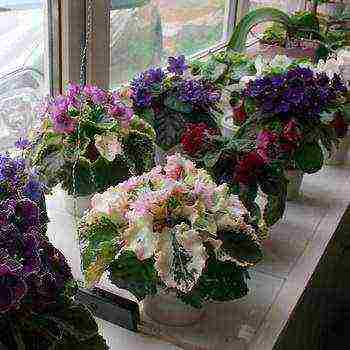 In the proposed material, the most popular indoor plants that can be successfully grown on a window are considered. What flowers can be planted on the windowsill and not worry about their well-being? The answer to this question can be found on this page. The flowering and decorative crops are considered: begonias, fuchsias, geraniums, violets and cacti.
In the proposed material, the most popular indoor plants that can be successfully grown on a window are considered. What flowers can be planted on the windowsill and not worry about their well-being? The answer to this question can be found on this page. The flowering and decorative crops are considered: begonias, fuchsias, geraniums, violets and cacti.
Violet on the windowsill and her photo
The violet on the windowsill is a wonderful interior decoration. Velvety round leaves, delicate flowers - this is an African plant from the forests of the Uzambar Mountains. For its resemblance to violets, it was called the Usambar violet or violet-shaped Saintpaulia (after the name of its discoverer, Baron Saint-Paul Hiller). At the end of the 19th century, the newly discovered Saintpaulia was shown at a gardening exhibition in Belgium, and so began its triumphant march across Europe. For 100 years, hundreds of varieties with simple and double flowers have been bred from the discreet dark purple wild Saintpaulia. With proper care, Saintpaulia blooms up to 10 months a year, replacing wilted flowers with blossoming buds.
Look at the violets on the windowsill in the photo of various varieties of this plant:


Cacti on the window and windowsill
Cacti on the window have long settled on the windowsills of indoor plant lovers, delighting with juicy green stems. Experienced flower growers also bloom cacti. The flower is an indicator that the cactus on the windowsill is provided with complete comfort. Most often, the cactus of the rainforest, the Schlumberger epiphyte, blooms in the apartments. It blooms around Christmas, when summer begins in its homeland, South America. For this he was called the Christmas cactus, or the Decembrist.In winter, large bright flowers and epiphytic cacti, epiphyllums, bloom.
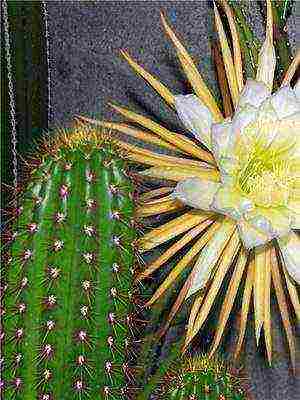
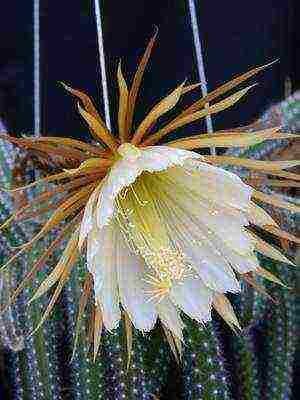
White flowers of selenicereus ("moon cactus") with a strong aroma bloom at night, and by morning they fall. In the jungle, these largest of all cactus flowers (up to 24 cm) await nocturnal guests - moths and bats. Bright flowers of prickly pears or chamecereus are intended for daytime pollinators - bees, beetles, ants.
Fuchsias on the window
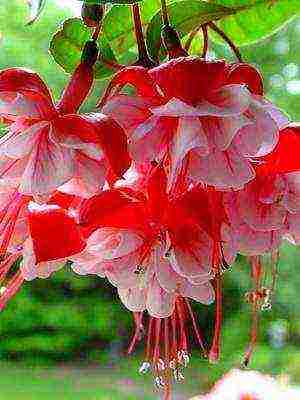
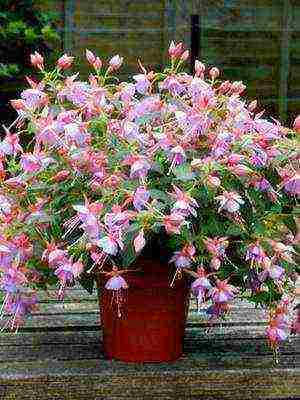
More than 300 years ago, the French monk and botanist Charles Plumier brought from South America a small lush shrub with delicate flowers. He named this plant fuchsia, after his German colleague Leonard Fuchs. No one was left indifferent by fuchsia flowers, similar to ballerinas, with a small head - a thickening of the peduncle, a fluffy skirt made of colored sepals and petals and thin legs - stamens and a pistil. Travelers brought new types of fuchsias, from which hundreds of varieties were bred. Growing in cool foothills in open places, fuchsias on the window are not demanding for heat, but they need bright light and good watering. At home, fuchsia blooms in summer, and in our country it blooms at the beginning of winter, painting the gray despondency with a riot of colors.
Geranium on the windowsill

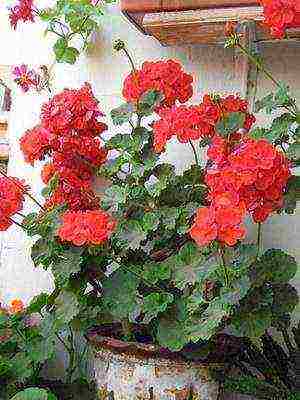
Geraniums on the windowsill recently broke all records in popularity among indoor plants. The concept of "home comfort" was inextricably linked with the blooming geraniums on the windowsill. The correct name for this plant is pelargonium (geranium is its wild relative from our forests). The Dutch introduced the Europeans to pelargonium, to whom we owe the spread of many ornamental plants. They brought it from their colonies in South Africa 300 years ago. Unpretentious, easily propagated by seeds and cuttings, geranium was available to everyone and often adorned the homes of ordinary people.
Begonia on the windowsill
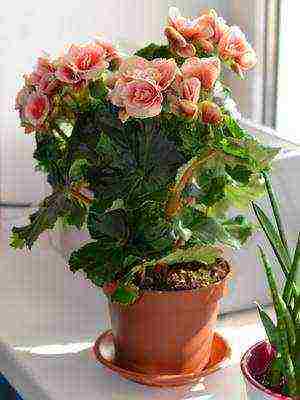

Each begonia flower is adorned with a bright perianth of sepals and petals. In alfalfa begonia, medium-sized perianths of white or pink color reveal a small yellow flower. Large flowers of decorative varieties of tuberous begonias on the windowsill are not inferior in splendor and beauty to roses. In winter, unpretentious begonias bloom in pots on windowsills, in summer they can be planted in flower beds. Growing rapidly, they will decorate a balcony, courtyard or garden with lush flowering.
Novolesnaya st., 3 bldg. 2
WHAT GARDEN FLOWERS CAN BE GROWED ON THE WINDOWSILL
The apartment looks very gorgeous when on the windowsill there are not just indoor plants, but garden ones. This greatly transforms the interior of the room. Many plants are medicinal, which will help to solve health problems with their help, even in deep winter.
On the windowsill, you can grow petunias, salvias, begonias, zinnias, lobelias, tagetes, geraniums and dahlias. Moreover, garden flowers can be placed both on the south, east, and on the north and west sides. Tagetes, annual asters, low nasturtiums, as well as annual climbing plants - sweet peas, beans, beans, echinocystis grow well in the shade. They feel equally good in the sun and in the shade of petunia, nasturtium, calendula, cosmeya, and fragrant tobacco. Very good and wonderful tobacco, common under the name of fragrant tobacco. It blooms only in the evening and at night, filling the air with a delicate aroma, during the day the flowers close. Even in freezing temperatures, when it is cold on the windowsill, tagetes blooms, it is also called marigolds. Many varieties of a wide variety of flowers are now on sale, including lilies, roses, gladioli, adapted for growing on balconies and window sills. There is also a large amount of specialized literature, with the help of which you can choose the optimal bouquet of plants.
Correct and timely agricultural practices that allow growing healthy plants and increase their resistance are an important preventive measure in the fight against pests and diseases.
Indoors, flower plants are especially often damaged when agricultural technology is violated. For example, irregular watering leads to cracking of the stem of chrysanthemums, pelargoniums, tulips. From a lack of moisture, tuberous begonia sheds its buds, leaves of azaleas fall, young shoots of hyacinths die. Excessive watering causes yellowing of leaves, rotting of roots and death of plants. Poor lighting of the mother plants of chrysanthemums leads to rotting of the cuttings during rooting. Dry air promotes the reproduction of spider mites, and excess moisture favors the development of gray mold, the spread of leaf nematodes. Iron deficiency with an excess of calcium in the soil causes chlorosis on the leaves. With excess nitrogen nutrition, plants fatten and poorly resist infection. With some growing techniques, healthy plants can be obtained even from diseased mother plants. For example, if the mother plants of chrysanthemums are infected with verticillium, they should be stored at 3-8 degrees. In February, cuttings are taken from them, rooted, and in March - April, the tops are cut off from them for rooting - plants that are free from infection are obtained.
You can get seeds from flowers yourself, but for this they must be fertilized. You can use a brush to get the pollen from the anthers, or, if the flowers are small, fold your fingers as if for a click and give your middle finger a few light and frequent clicks on the flower stalk to shake it quite strongly; pollen spills out in the form of a cloud, and fertilization is carried out. For the described operation, the time is chosen around noon on a clear sunny day. To get a healthy seed, you need to collect seeds only from well-ripened and healthy plants, from shoots of the first and second order. After collecting, you need to sort them out, remove immature and infected ones. Healthy seeds should be stored in a dry place. Correct and timely feeding of plants can increase their resistance and change metabolism in a direction unfavorable for the development of pests and diseases. When feeding chrysanthemums and carnations with phosphorus and phosphorus-potassium fertilizers, they are least of all infected with aphids, phosphorus and potassium salts reduce the intensity of blackleg development in flower seedlings, rust of remontant carnation, gray mold on cyclamen and some other diseases.
For a more complete assimilation of fertilizers by plants, it is recommended for most crops to apply lime to the soil, since it neutralizes acidity and helps the transition of sparingly soluble compounds into soluble ones. The use of resistant varieties is also a preventive measure.
To get the most out of it, you need to understand the types of land used in indoor farming and how to mix them up. To make up mixtures, it is enough to have 4 types of soil: turf, leaf, peat, humus. If necessary, add sand, coal, marsh moss, ash, lime. To improve the composition of sod soils, sand is added to them. The most suitable is coarse-grained river or lake white sand. Sphagnum marsh moss gives any soil looseness, lightness, hygroscopicity. The collected moss is dried and ground into powder before use. Unmilled moss is used to cover the soil surface in pots to prevent it from drying out in hot weather. Young perennials should be planted in lighter soil with a high proportion of leafy soil. As the plant grows and its root system develops, the proportion of leafy land decreases, and the proportion of sod land increases. Timely transplanting and transshipment of plants is essential. The size of pots and other containers during plant transplantation increases gradually, by 1–1.5 cm each time, because the excess soil, not penetrated by plant roots, easily sours, it spoils the rest of the earth, and the plant dies.
When replanting, more or less damage to the roots always occurs. However, this damage is quickly compensated by their exuberant growth in the new land. Plants should not be transplanted just before they enter the time of flowering and fruiting.
In winter, illumination with fluorescent lamps gives a good result for the development of the vegetative system of plants. The most suitable are 40 watts. Fluorescent lamps are much more economical, and it is also convenient that they are made in the form of tubes and hardly heat up, so they can be placed anywhere and even in the midst of greenery. On a cold window, heat-loving plants are not comfortable, especially since the operating heating dries out the roots, and the stems freeze. Therefore, you need to either remove them from the windowsill on the table, away from the radiators, or obscure them, for example, with foil.
And now specifically about zinnias and chrysanthemums.
Zinnia is a light and heat-loving plant that does not tolerate even light frosts. For abundant long flowering, it requires a soil rich in humus, minerals and nutrients, well-cultivated and drained soil with a neutral acid reaction. Grows well in full sun. Does not tolerate excess moisture in the soil and prolonged drought, in which the inflorescences become smaller, and the flowers from the edges dry out. It responds well to the introduction of organic and mineral fertilizers during planting and in fertilizing, which are carried out 2-3 times per flowering.
Zinnia is propagated by seeds. Large seeds germinate in 4-6 days. With a rare sowing of large seeds, you can do without picking. Planting is carried out in pots with a diameter of 25-40 cm. The grown seedlings can be pinched to speed up the tillering of plants. Zinnia seeds are harvested when the inflorescences are brown.
Chrysanthemums are short-day plants. At the end of flowering, the chrysanthemum must be cut, if this is not done, the plants will give all their strength to grow into a large bush, and will no longer bloom. In any case, it is easier to buy a new plant than to rejuvenate and make the old bloom. Too large a plant needs to be divided in half, for this the root ball is divided. Thanks to division, you can get not one, but two whole flower pots with a flowering plant. Chrysanthemums in flower pots usually do not exceed 30 cm in height. The purchased plants practically do not grow in height and width, but they are surprisingly exuberant flowering. All chrysanthemums have a characteristic, rather pungent smell, so it is better to place them next to delicate-smelling plants. If there is not enough space in the apartment, then plant several chrysanthemums with inflorescences of different colors in one pot. The pots can be painted in a suitable color. Chrysanthemums of the Cascade type with drooping stems are known. The stems of these plants can be tied to wire supports. Chrysanthemums are completely problem-free plants. In addition, they bloom for a long time - within 6-8 weeks. At this time, the wilting buds should be removed to initiate the plants to set new flower buds. If you bought chrysanthemums in suitable containers, then the plants do not need to be transplanted. If the capacity is too small, then it is better to transplant them.
Chrysanthemums are usually sold in small plastic flower pots that dry out very quickly. Therefore, plants need frequent and abundant watering. The soil in the pot should always be moist. If the plant is in a warm place, then it should be watered twice a week. Since chrysanthemums do not live long, they do not need feeding. Chrysanthemums are very sun-loving, however, plants should be shaded from direct sunlight at midday. Chrysanthemums can grow for a long time at low temperatures (they tolerate them well). The most optimal temperature for their growth is 10-15 degrees. If the air temperature at the window is higher than the specified one, then the plants need more frequent watering.
Materials:
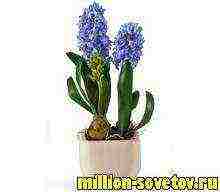 Now more and more home growers prefer garden flowers. On the windowsills, dahlias, asters, sweet peas and many other flowers look beautiful, which used to please the eye exclusively in the country or in the garden. Fashion trends are forcing breeders to come up with new varieties of roses, lilies, gladioli and other flowers that will thrive indoors. But, how beautiful garden flowers in pots and containers in our house will look. How to grow them will be discussed in this article.
Now more and more home growers prefer garden flowers. On the windowsills, dahlias, asters, sweet peas and many other flowers look beautiful, which used to please the eye exclusively in the country or in the garden. Fashion trends are forcing breeders to come up with new varieties of roses, lilies, gladioli and other flowers that will thrive indoors. But, how beautiful garden flowers in pots and containers in our house will look. How to grow them will be discussed in this article.
To solve the issue of forcing plants, you must first of all choose the correct composition of the earth and lighting. There are several types of land: peat, humus, turf and leaf. An earthen mixture is prepared from several types of soil with the addition of sand, crushed sphagnum moss and charcoal. Young plants prefer the presence of leafy and peat land in the composition.
If you do not have experience in drawing up a land mixture, then you can simply buy ready-made soil at a flower shop.
The best option is garden soil with rotted compost in a 2: 1 ratio. A little sand and charcoal are added to this mixture. You can also dig up some soil in the garden, mix with dry peat and add sawdust.
As for lighting, then you need to decide what kind of flowers will be grown. For example, a tulip can bloom even in the basement in the absence of light, but there are also light-loving plants. When planting, you can simply read about colors in a reference book or use the Internet.
Garden flowers, for home floriculture, can be planted with seeds (cornflower, calendula, forget-me-not, petunia, etc.) or bulbs (daffodils, tulips, crocuses).
If everything is quite simple with seeds, then bulbous flowers are more demanding for planting. The bulbs of tulips, crocuses and other plants are completely covered, and in daffodils and hyacinths only 2/3. The bulb is pressed into damp ground and sprinkled as much as needed for the type of plant. Then it is watered and sprinkled again.
If you want to please your loved ones with blooming tulips on March 8, then you need to plant the bulbs at the end of September. There they will grow until the frost begins. Watering is required during this period. Before the first frosts, you need to place a pot of tulip bulbs in a dark place in our apartment. The practice is to put the pot on the bottom shelf of the refrigerator. Three weeks before the women's holiday, the pots are placed on the windowsill and the daylight hours are increased with the help of additional lighting.
So you can prepare almost all bulbs for the holiday. The main thing is to calculate the removal of the plant “into the light”. For Crocuses, for example, it is 12 days before the holiday.
In addition to flowers, green beds at home are now very popular. Spices not only delight the manhole, but also fill the room with a pleasant smell. Basil on the windowsill works very well in this case.
And finally, I want to share a recipe for a tincture for watering plants. One kilogram of fresh nettle is filled with 10 liters of water. The mixture is infused for several days. Then it is filtered. This tincture increases soil fertility and increases plant resistance to a variety of diseases.
Grow garden flowers at home. Blooming garden flowers look very beautiful and delight the eye even in the winter season.
Materials:
Dec 10/12
No matter how beautiful the windows or curtains themselves are, all the same, indoor flowers cool the atmosphere of the room, fill it with a special atmosphere and comfort. It so happened historically that in city apartments most often they grow flowers on the windowsill or on the loggia (balcony) - it is here that the plants receive maximum sunlight for full development and rapid growth.
In principle, any indoor flowers, especially those that have a long flowering period, are appreciated.But, in general, each flower is unique in its own way, and even if the plant does not bloom, such as dracaena or sheflera, this is not a reason not to plant it in your "mini greenhouse" on the window.
Among the flowering indoor plants, the most popular are violets, poinsettia, begonias, orchids, spathiphyllum, and various types of flowering cacti. Most of these plants are valued not only for their beautiful flowers, but also for their relative simplicity in care. All you need to do is water, feed and transplant the flower on time so that it pleases with rich greenery and luxurious flowering.
Not only indoor flowers are grown on the windowsill, but also garden flowers. Petunia, chrysanthemum, nasturtium, aster, fragrant tobacco look nice. For good growth of such flowers, you need to correctly compose the soil mixture. Usually, they take 4 types of land: humus, peat, turf and leaf. While the plant is young, it is better if leafy soil predominates in the soil, it is lighter. But as the flower grows, it needs to be transplanted into soil with an increasing amount of sod land.
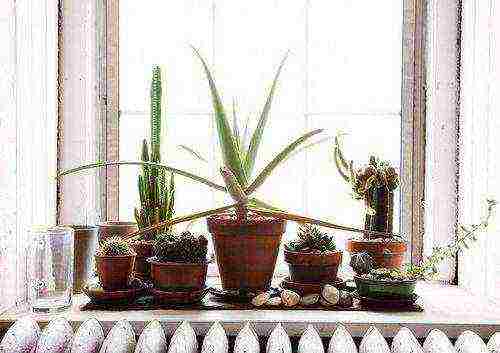
Flowers on the windowsill photo

Indoor flowers on the windowsill photo
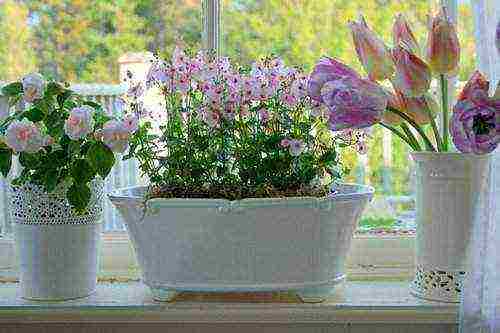
Vases with flowers on the windowsill
In autumn and winter, when daylight hours are significantly reduced, the most necessary things for a houseplant are sunlight and moisture. Watering is carried out depending on the type of plant, some flower needs abundant irrigation, another should not be flooded with water in any case. If the plant is moisture-loving, then it is better to organize watering through the pallet, in this case expanded clay is poured into the pallet, which is moistened with water, and a flower pot is placed on it.
The intensity of watering also depends on the temperature in the room; as the temperature decreases, the frequency of watering must be reduced. And when the central heating is turned on, it may be necessary to remove the flowers from the window sill heated by the battery to another place, at least put them on the floor or use special flower shelves on the windowsill to raise them away from the heat source.
Top dressing of indoor plants is carried out in the spring-summer period and is gradually reduced from September-month, since the plant prepares for the so-called hibernation and needs rest. But starting in spring (March-April), you can start feeding the flowers with fertilizers and replanting them. By the way, about transplanting: basically, plants are transplanted as needed (as the root system develops), when they see that the current pot is small for it, but there are some types of flowers that require transplanting regularly, every 1-2 years.
In summer, abundant watering and feeding of plants is also required; some types of flowers require spraying of the leaves. And at the same time of the year, the mini greenhouse can be taken out onto the balcony, let the plants "breathe" in fresh air and enjoy the sunshine. It should be noted here that at any time of the year, and in the summer months in particular, you need to protect indoor flowers on the balcony and on the windowsill from direct sunlight.
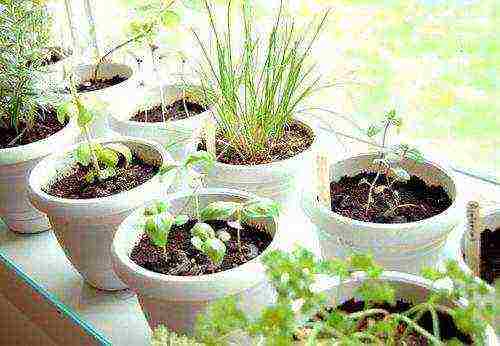
Growing flowers on a windowsill

Growing flowers on a windowsill
How to arrange flowers on a windowsill
Flowers on the windowsill look beautiful if they are about the same height and are placed close to each other, when each flower is part of a common lush greenery. But here you need to take into account that flowers need a sufficient amount of light, and if they stand too close to each other, they will not receive their dose of sunlight. In addition, they need to be constantly turned from one side to the other to the light, and for such movements, you also need free space.
But how to place flowers on the windowsill if there are plants of different sizes? In this case, the principle "one to three" works well (one large flower and three small ones next to it).You can also use special stands for flowers on the windowsill, in this case, large plants are placed on the lower tier, and small and curly ones are placed on top.

Racks for flowers on the windowsill
Wrought iron stands for flowers on the windowsill are also perfectly placed by the window. Such stands can be of different shapes (round, triangular, rectangular with or without curls) or a pole in the full height of the window with branches on the sides for holes for pots.
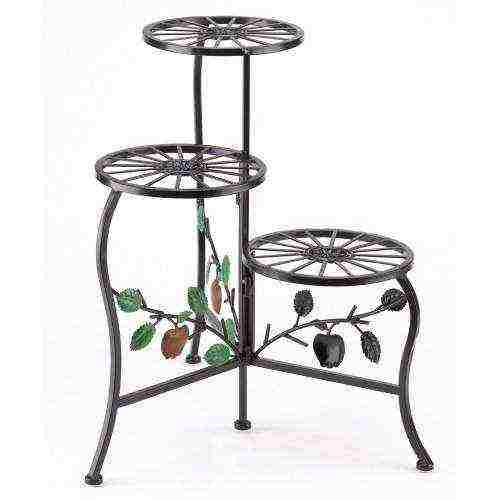
Wrought iron stands for flowers on the windowsill
Shelves for flowers on the window also look great. As a rule, they are made of transparent glass so that they do not give shade and do not interfere with the penetration of sunlight. In addition, these shelves have a very aesthetic appearance.
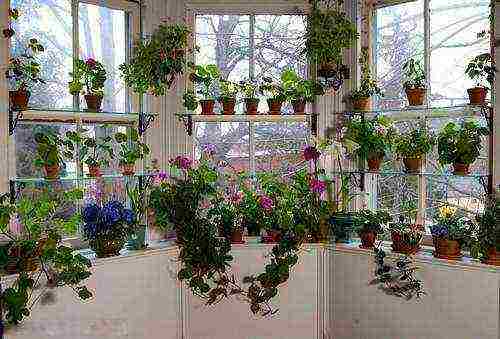
Flowers on the windows photo

Shelves for flowers on the windowsill
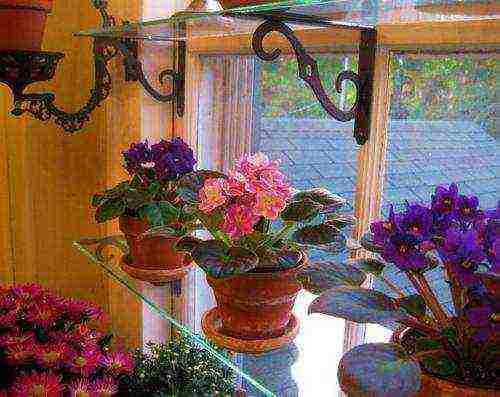
Glass shelves for flowers on the windowsill
Another option for placing flowers on the windows is pots. They can be both ceramic and plastic - today there is an abundance of this kind for every taste. But really attractive are handmade flower pots, for example, knitted ones.
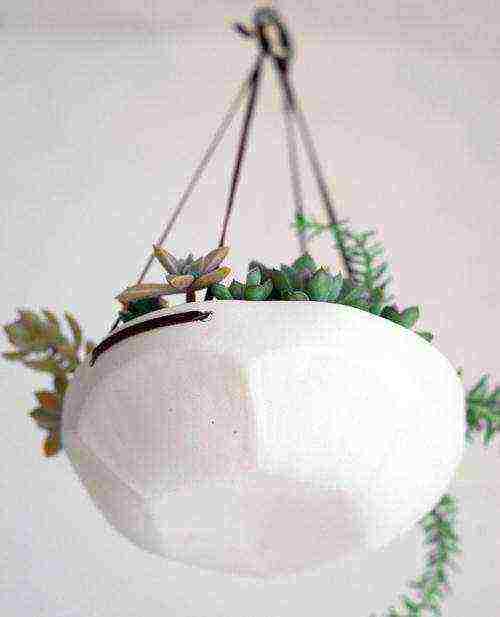
Planter for flowers on the windowsill
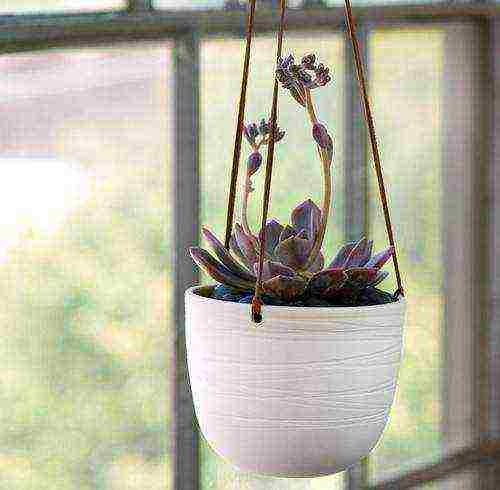
How to place flowers on a windowsill
Finally, I must say about flower pots. If you have a white metal-plastic window, then it is advisable to keep the flowers on the windowsill in white pots, and not in brown or green ones. And, of course, it is better to place pots of the same color on one window sill, so the "picture" will have a more attractive appearance.
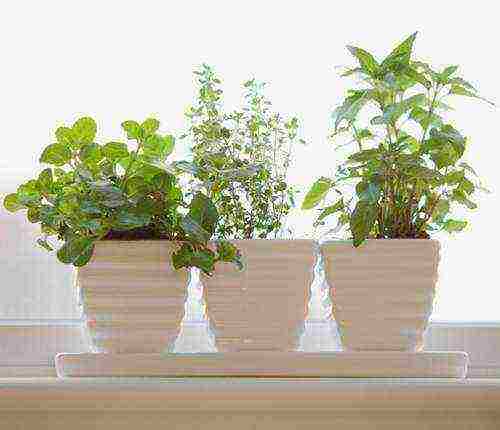
Flower stands on the windowsill
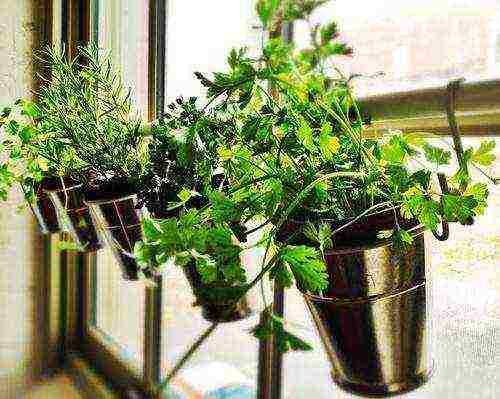
Flowers on the windowsill photo


